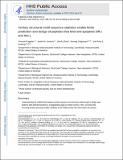| dc.contributor.author | Frappier, Vincent | |
| dc.contributor.author | Jenson, Justin Michael | |
| dc.contributor.author | Zhou, Jianfu | |
| dc.contributor.author | Grigoryan, Gevorg | |
| dc.contributor.author | Keating, Amy E. | |
| dc.date.accessioned | 2021-09-08T14:19:02Z | |
| dc.date.available | 2020-04-14T19:29:40Z | |
| dc.date.available | 2021-09-08T14:19:02Z | |
| dc.date.issued | 2019-02 | |
| dc.date.submitted | 2018-12 | |
| dc.identifier.issn | 0969-2126 | |
| dc.identifier.uri | https://hdl.handle.net/1721.1/124632.2 | |
| dc.description.abstract | Understanding the relationship between protein sequence and structure well enough to design new proteins with desired functions is a longstanding goal in protein science. Here, we show that recurring tertiary structural motifs (TERMs) in the PDB provide rich information for protein-peptide interaction prediction and design. TERM statistics can be used to predict peptide binding energies for Bcl-2 family proteins as accurately as widely used structure-based tools. Furthermore, design using TERM energies (dTERMen) rapidly and reliably generates high-affinity peptide binders of anti-apoptotic proteins Bfl-1 and Mcl-1 with just 15%–38% sequence identity to any known native Bcl-2 family protein ligand. High-resolution structures of four designed peptides bound to their targets provide opportunities to analyze the strengths and limitations of the computational design method. Our results support dTERMen as a powerful approach that can complement existing tools for protein engineering. | en_US |
| dc.description.sponsorship | NIGMS (Award R01-GM110048) | en_US |
| dc.language.iso | en | |
| dc.publisher | Elsevier BV | en_US |
| dc.relation.isversionof | http://dx.doi.org/10.1016/j.str.2019.01.008 | en_US |
| dc.rights | Creative Commons Attribution-NonCommercial-NoDerivs License | en_US |
| dc.rights.uri | http://creativecommons.org/licenses/by-nc-nd/4.0/ | en_US |
| dc.source | PMC | en_US |
| dc.title | Tertiary Structural Motif Sequence Statistics Enable Facile Prediction and Design of Peptides that Bind Anti-apoptotic Bfl-1 and Mcl-1 | en_US |
| dc.type | Article | en_US |
| dc.identifier.citation | "Tertiary Structural Motif Sequence Statistics Enable Facile Prediction and Design of Peptides that Bind Anti-apoptotic Bfl-1 and Mcl-1." Structure 27, 4 (April 2019): 606-617.e5. © 2019 Elsevier Ltd | en_US |
| dc.contributor.department | Massachusetts Institute of Technology. Department of Biology | en_US |
| dc.contributor.department | Massachusetts Institute of Technology. Department of Biological Engineering | en_US |
| dc.contributor.department | Koch Institute for Integrative Cancer Research at MIT | en_US |
| dc.relation.journal | Structure | en_US |
| dc.eprint.version | Author's final manuscript | en_US |
| dc.type.uri | http://purl.org/eprint/type/JournalArticle | en_US |
| eprint.status | http://purl.org/eprint/status/PeerReviewed | en_US |
| dc.date.updated | 2020-04-06T17:26:56Z | |
| dspace.date.submission | 2020-04-06T17:26:58Z | |
| mit.journal.volume | 27 | en_US |
| mit.journal.issue | 4 | en_US |
| mit.license | PUBLISHER_CC | |
| mit.metadata.status | Complete | en_US |
